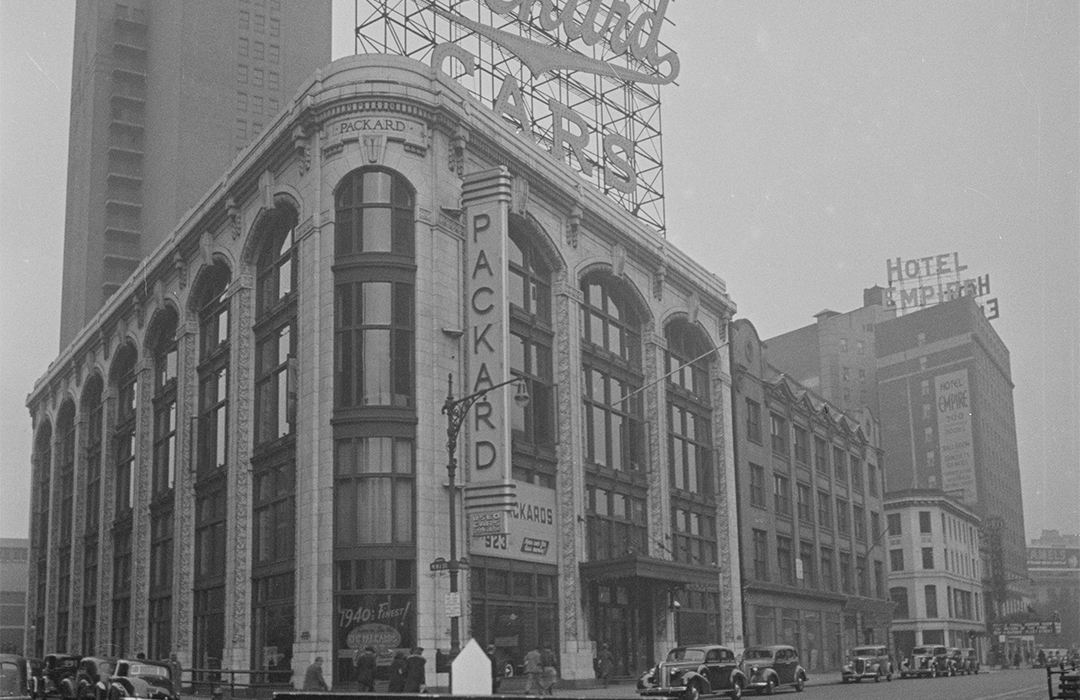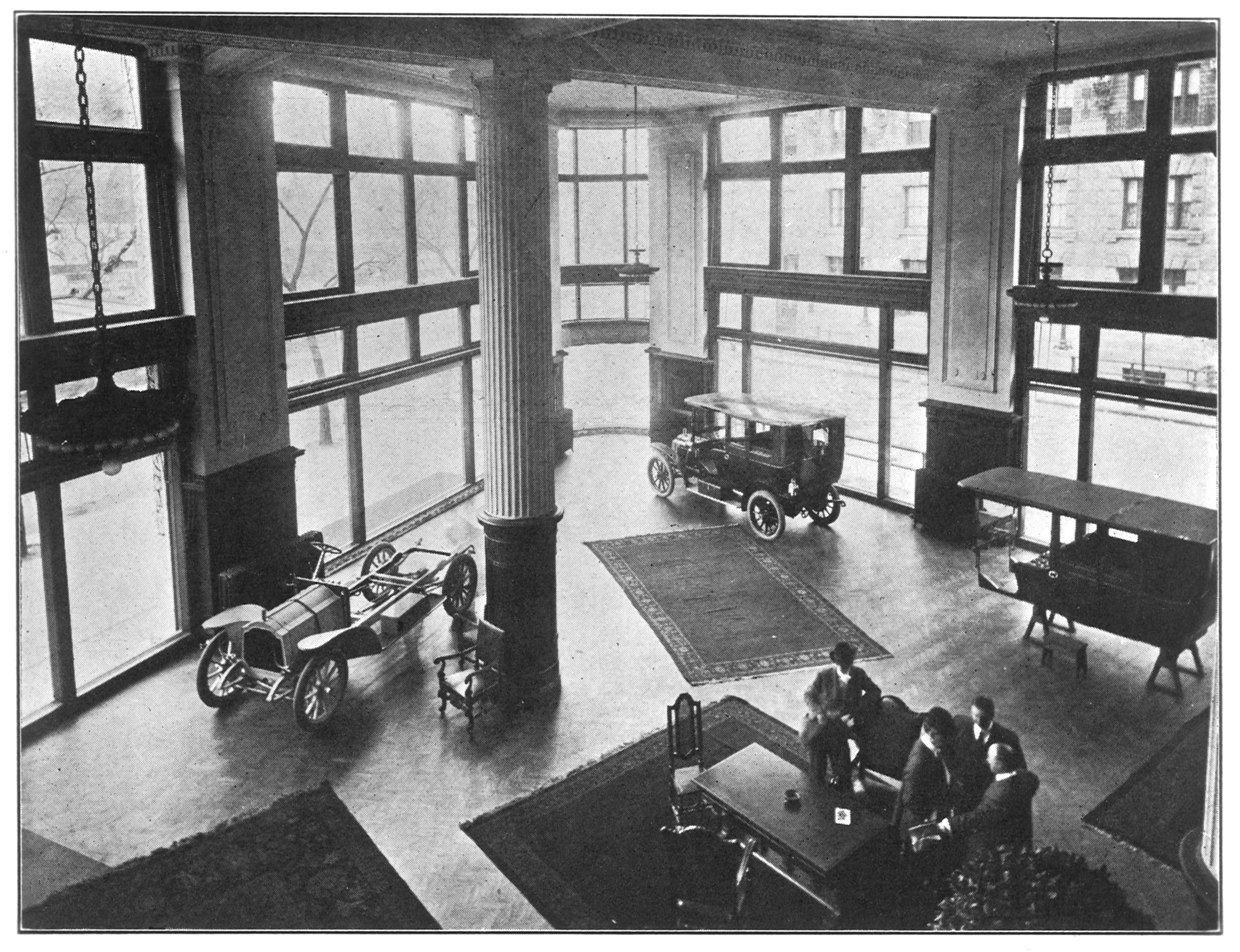
1861-1869 Broadway – The Packard Motor Car Building
by Tom Miller
Born in Prussia in 1869, architect Albert Kahn was based in Detroit in 1903 when he designed the Packard Motor Car Company’s automobile factory. Three years later, he was commissioned to design the firm’s New York City headquarters. By then, Kahn and his brother Julius had originated a process of reinforced concrete that revolutionized industrial construction.
In May 1906, the Record & Guide reported that Packard Motor Car Co. had acquired the property at the northwest corner of Broadway and 61st Street where it “will eventually erect a garage building for its own occupancy.” Three months later, on August 25, the journal noted, “it is announced this week that an armored concrete building of three stories, for the Packard Motor Car Company, is planned for the northwest corner of Broadway and 61st st.” Five days later, Kahn filed his plans for a “concrete, brick and stone garage building” to cost $200,000.
Kahn and his brother Julius had originated a process of reinforced concrete…
The Packard Motor Car Building was completed in 1907. Vast and dramatic full-height arches flooded the interior with natural light. In its December issue that year, Architects’ and Builders’ Magazine explained, “While the exterior shows a four-story building, the building is actually three stories, as the first two stories are made into one so as to give a lofty interior.” (The ground floor showroom had a mezzanine.) “The office is a finely finished apartment, with wood mosaic floors, covered with heavy rugs,” said the article.
Customers who purchased a Packard automobile were purchasing top-notch service as well. Mechanics not only serviced the vehicles on site but would travel to wherever a Packard had broken down. Around midnight on January 23, 1910, two mechanics, Robert Clark and John J. Egan, and the firm’s chief electrician, Leo Bradfield, finished a call in Newark. On the way back in the Packard service car, they encountered John Lavin, an off-duty street railway conductor. The 21-year-old had been waiting for a trolley car, “but was in a hurry to get home and hailed the automobile,” reported The Sun. “He climbed into the rear seat with Egan and Clark.” Lavin’s impatience would cost him his life.
John Egan decided to take the newly finished Newark Turnpike Bridge over the Hackensack River. The Sun said Egan later recounted that the car “was going at a fast clip when it approached the new bridge at about 1:30 o’clock…There is a sharp turn just west of the bridge. In attempting to negotiate it the machine skidded and turned turtle.” The car smashed against a pile of steel girders left over from the bridge construction. The three Packard employees were thrown from the car, but Lavin “was pinned between the girders and the machine and was killed instantly.”
The general manager and vice-president of Packard Motors Export Corporation was Colonel Frederick Cardway in the years after World War I. In 1920, his bitterness over America’s former enemy had not waned, and when he became suspicious that the Postmaster General was buying recycled German fighter biplanes to use as mail carriers, he was outraged. He fired off a letter from 1861 Broadway, accusing the United States government of buying German aircraft from John M. Larsen and the J. H. Aircraft Corporation. The New-York Tribune reported on September 3, 1920, that a “thorough investigation” of the airplanes had been completed and “each has been found to be 100 per cent [sic] American.”
he became suspicious that the Postmaster General was buying recycled German fighter biplanes to use as mail carriers…
The article also mentioned, “Mr. Larsen had been agent for the Packard cars in Denmark and Sweden for several years.” That was no longer the case. “Mr. Larsen’s resignation was offered partly for business reasons and partly for personal and social differences with Mr. Cardway.”
A perhaps unexpected ceremony was held in the showroom in December 1926. The Broadway Association held a days-long Broadway Celebration “which was climaxed by a brilliant Parade on the last day of the Celebration in which a score of bands, representing various civic and military organizations, competed for the prize,” reported the Vaudeville News. Winning the “handsome gold cup” was Keith’s Boys Band. On December 11, the newspaper said, “the presentation took place during the past week at 1861 Broadway, which happens to be the New York branch of the Packard Agency of which Lee J. Eastman, president of the Broadway Association, is president and general manager.”
On February 24, 1958, The New York Times reported that the Studebaker Packard Corporation had sold 1861 Broadway to John A. Dillard. The article noted, “the investment was made…largely because of a favorable outlook for real estate values in the vicinity of the proposed Lincoln Square redevelopment project.” Five years later, the American Bible Society purchased the property. Albert Kahn’s striking Packard Motor Car Building was demolished to make way for the society’s 12-story headquarters designed by Roy O. Allen Jr. and Donald C. Smith of Skidmore, Owings & Merrill. That building was demolished in 2017, only to be replaced by another building by Skidmore, Owings & Merrill, named The Park Loggia.
Tom Miller is a social historian and blogger at daytoninmanhattan.blogspot.com



